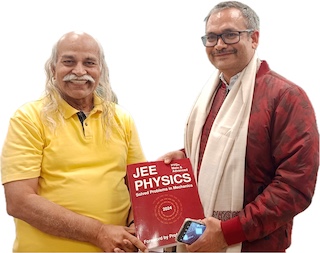Two identical ladders, each of mass M and length L are resting on the rough horizontal surface
Problem: Two identical ladders, each of mass M and length L are resting on the rough horizontal surface as shown in the figure. A block of mass m hangs from P. If the system is in equilibrium, find the direction and magnitude of frictional force acting at A and B. (IIT JEE 2005)
Solution: Let the block of mass $m$ hangs from the point P by a string attached to the hinges of the two ladders.
Newton's second law gives the tension $T$ in the string as $T=mg$. By symmetry, string tension pulls down each ladder by a force \begin{align} T/2=mg/2.\nonumber \end{align} By Newton's third law, the reaction forces acting on the two ladders at the hinge point P are equal and opposite. These are shown by $R_1$ and $R_2$ in the figure. By symmetry, the normal reaction $N$ at A and B are equal, the friction forces $f$ at A and B are equal in magnitude but opposite in direction. Another force acting on both the ladders is their weight $Mg$ which pass through their centre of mass. In equilibrium, the resultant forces on the two ladders are zero i.e., \begin{align} \label{xsb:eqn:1} &N+R_2-Mg-mg/2=0,\\ \label{xsb:eqn:2} &f=R_1,\\ \label{xsb:eqn:3} &N-R_2-Mg-mg/2=0. \end{align} The above equations give $R_2=0$ (as expected!) and $N=(M+m/2)g$. In equilibrium, the net torque about any point is zero. Thus, the torque about the point P for the left ladder is \begin{align} \label{xsb:eqn:4} Mg(L/2)\cos\theta+fL\sin\theta-NL\cos\theta=0. \end{align} Substitute $N=(M+m/2)g$ in above equation and simplify to get \begin{align} f=\left(\tfrac{M+m}{2}\right)g\cot\theta.\nonumber \end{align}
More Solved Problems on Equilibrium of Rigid Bodies
- A uniform cube of side a and mass m rest on a horizontal table (IIT JEE 1984)
- A rod of weight W is supported by two parallel knife edges A and B (IIT JEE 1997)
- A cubical block of side L rests on a horizontal surface (IIT JEE 2000)
- A block of base 10 cm by 10 cm on inclined plane - sliding and toppling (IIT JEE 2009)
- In the figure a ladder of mass m is shown leaning against a wall (IIT JEE 2014)
- A uniform wooden stick of mass 1.6 kg and length l rests in an inclined manner (IIT JEE 2016)
- In a physical balance working on the principle of moment balance (JEE Mains 2017)
- A uniform rod AB is suspended from a point X (JEE Mains 2018)
- Equilibrium of Rigid Bodies
